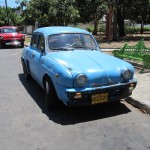CUBA 2011
Cuba 2011
One of the things Cuba is best known for is its frozen-in-time classic car scene, a consequence of the break in relations with the USA when Fidel Castro gained control of the country and established a communist regime in 1961. There is a general feeling that things are going to change before too long, so I decided that now was the time to go.
The plan was to fly to Havana, stay 3 nights in the city, then pick up a hire car and travel around the country for a week. The main source of information and basis for my planning was the Rough Guide to Cuba, referred to hereafter as the RG.
The flight from Gatwick to Havana via Madrid with Air Europa went well and the immigration procedure was not too much of a pain, taking about 20 minutes. The next stage was to get some Cuban money, which can only be obtained on arrival. Cuba has a strange dual currency system, with the National Peso (CUP) for Cubans and the Convertible Peso (CUC) for foreigners. The CUC is pegged to the US Dollar and is not really convertible anyway, because it cannot be bought or sold outside the country. The US Dollar is no longer accepted as currency and there is a 10% penalty for changing Dollars into CUCs.
This means that most people arriving from abroad have to get money at the airport, causing big queues at the change counters, and that was certainly the case when I arrived. Luckily, just as I joined a massive and disorderly queue I was approached by a very smart taxi driver who took me upstairs to another counter where there were two people waiting. Back downstairs the driver introduced me to an equally smart young man of about 20 who was his son and we went out to their vehicle which was a small car, a Citroen Visa diesel in the taxi firm's livery, with a meter. The airport is about 16Km (10 miles) from the centre of Havana, and there is no public transport link. As the son drove along the dark, bumpy unmarked road from the airport they explained that the car had done 400,00km (250,000 miles), and was very good. When they discovered that I was British they were delighted and said the British were the best tourists because they always gave a 10 dollar tip, so at least I was left in no doubt about what was expected of me.
There was not much traffic, but at one point we came up behind a 1950s American car which apparently belonged to one of our driver's friends. This led to a race away from the lights with some overtaking on the inside, but the American car won conclusively.
 Eventually we arrived at my hotel, the Inglaterra, in the middle of Havana. It might seem rather unadventurous of me to stay at a hotel called 'The England', but the Inglaterra is the oldest hotel in Havana, perhaps the oldest in Cuba, and has tremendous character as well as being very conveniently situated. Winston Churchill is supposed to have stayed there in the 1930s. It was listed by the Rough Guide, the Insight Guide and some others, and it was only after I had booked three nights on the internet that I discovered that out of 97 reviews on TripAdvisor 90 were bad. They cited scruffy rooms, rude staff and poor food, so it sounded like the sort of place I usually stay in, though the high ornate ceilings and chandeliers countered that impression.
Eventually we arrived at my hotel, the Inglaterra, in the middle of Havana. It might seem rather unadventurous of me to stay at a hotel called 'The England', but the Inglaterra is the oldest hotel in Havana, perhaps the oldest in Cuba, and has tremendous character as well as being very conveniently situated. Winston Churchill is supposed to have stayed there in the 1930s. It was listed by the Rough Guide, the Insight Guide and some others, and it was only after I had booked three nights on the internet that I discovered that out of 97 reviews on TripAdvisor 90 were bad. They cited scruffy rooms, rude staff and poor food, so it sounded like the sort of place I usually stay in, though the high ornate ceilings and chandeliers countered that impression.
The staff seemed pleasant enough, but the air-conditioned room was scruffy and had no proper window.
Havana
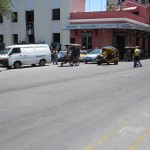 In the morning, after a mediocre buffet breakfast I ventured out on to the town, to be greeted by shouts of "Amigo! Taxi!" the moment I set foot in the street, words that I would hear endlessly during my stay in Cuba. Apart from car-type taxis there are horse-drawn carriages, cyclo-taxis (tricycles with 2 seats behind the rider) and coco-taxis, strange little three-wheeled glass-fibre cabins with 2 or 3 seats behind the driver. Apparently the drivers of all these vehicles were my amigos.
In the morning, after a mediocre buffet breakfast I ventured out on to the town, to be greeted by shouts of "Amigo! Taxi!" the moment I set foot in the street, words that I would hear endlessly during my stay in Cuba. Apart from car-type taxis there are horse-drawn carriages, cyclo-taxis (tricycles with 2 seats behind the rider) and coco-taxis, strange little three-wheeled glass-fibre cabins with 2 or 3 seats behind the driver. Apparently the drivers of all these vehicles were my amigos.
Due to the hard economic conditions the traffic on the streets of Havana is lighter than in most other capital cities, but as a petrolhead it was impossible for me not to be awestruck by the number of American and other classic vehicles, which far exceeded expectation. To avoid boring normal readers I have confined discussion of this subject to a section at the end of the article.
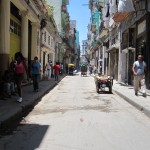 From the hotel I crossed the Parque Central opposite and spent the morning looking round Habana Vieja (Old Havana). There are many fine buildings in the narrow streets of the old town, some restored but mostly in various degrees of disrepair. I visited the car museum (of course) and the Camera Obscura, the mechanism of which was made by an English firm in the 1930s. The streets of the old town lead through to the harbour, with a fortress and a statue of Jesus Christ (being renovated) on the opposite bank.
From the hotel I crossed the Parque Central opposite and spent the morning looking round Habana Vieja (Old Havana). There are many fine buildings in the narrow streets of the old town, some restored but mostly in various degrees of disrepair. I visited the car museum (of course) and the Camera Obscura, the mechanism of which was made by an English firm in the 1930s. The streets of the old town lead through to the harbour, with a fortress and a statue of Jesus Christ (being renovated) on the opposite bank.
During the morning I had no problems with the famous hustlers who pester tourists for money in one way or another, but when I got my video camera from the hotel and tried to record some street scenes I had to give up because they would not leave me alone. This was the start of a problem that seemed to become an increasing nuisance as time went on. If you are walking or sitting down someone will come up to you, ask where you are from and tell you they have a friend in Shepherd's Bush or that they support Manchester United. The guide books, which are usually written by people with a love of the country and who speak the language fluently say some of them want to be friendly and practice their English, but in my experience they don't, all they want is your money. Eventually they will come straight out and ask for 2CUC for "baby milk". More on this subject later.
In the early afternoon the weather was very hot, too hot for me, so I retired to my air-conditioned room for a while, and then came out and had another go at making a video, in the street near the hotel. The area was less crowded than before and by some miracle hustler- free. Afterwards I walked past the ornate and imposing Gran Teatro (Grand Theatre) to the beautiful Capitol Nacional building, which was modelled on the one in Washington DC and is nearing the end of a total restoration. Just around the corner I came across an extraordinary place, a large compound surrounded by a wire fence inside which were the remains of about 15 steam railway locomotives, some dating from the 19th century. There was one that had been fairly well restored, but the others were in a very bad state. There was nothing to explain what it was all about.
free. Afterwards I walked past the ornate and imposing Gran Teatro (Grand Theatre) to the beautiful Capitol Nacional building, which was modelled on the one in Washington DC and is nearing the end of a total restoration. Just around the corner I came across an extraordinary place, a large compound surrounded by a wire fence inside which were the remains of about 15 steam railway locomotives, some dating from the 19th century. There was one that had been fairly well restored, but the others were in a very bad state. There was nothing to explain what it was all about.
Nearby was the Parque de la Fraternidad, where there were 60 or 70 American cars lined up for sale, and the entrance to Chinatown. Along the line I have been to a number of Chinatowns (though none in China) and I always say "when you have seen one you have seen 'em all", but that certainly didn't apply in this case, because there was nothing and no one Chinese in sight apart from the arch at the entrance. Perhaps the residents have all gone back to China to make the massive Yutong open top buses used to take sightseers round Havana.
Strangely it did not occur to me until afterwards, but the next day was 1st May, which would normally be Workers' Day, with massive celebrations in the Plaza de la Revolución (Revolution Square). However as it was a Sunday the event was put off until the Monday, but I decided to walk to the Square anyway. The first part of the route was along a street called Avenida Simon Bolivar lined with handsome 2- 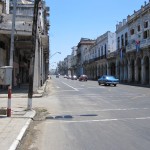 and 3-storey buildings with the pavements running through colonnades on each side. Many of the buildings were in quite poor condition, and the living accommodation on the upper floors looked pretty grim. There were people standing or sitting on the pavement all the way along, and it was a bit like running the gauntlet as I passed through the spaces between the columns. At the many junctions with side streets there were police standing on both sides of the road, a situation which the RG said could be intimidating, but personally I found it rather reassuring. The side streets themselves were narrow, dusty and roughly surfaced with old buildings containing poor quality multi-storey housing.
and 3-storey buildings with the pavements running through colonnades on each side. Many of the buildings were in quite poor condition, and the living accommodation on the upper floors looked pretty grim. There were people standing or sitting on the pavement all the way along, and it was a bit like running the gauntlet as I passed through the spaces between the columns. At the many junctions with side streets there were police standing on both sides of the road, a situation which the RG said could be intimidating, but personally I found it rather reassuring. The side streets themselves were narrow, dusty and roughly surfaced with old buildings containing poor quality multi-storey housing.
The street eventually widened into a broad avenue between commercial and public buildings, some quite imposing, and the whole area 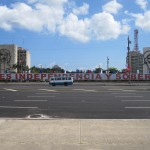 was a bit smarter. On the approach to the Plaza de la Revolución the buildings thinned out and there was some parkland. On one side of the square itself is a monument in the form of a 139m steeple with a white marble bust at its base to José Martí, who is credited with achieving independence for Cuba. On the opposite side are the Ministry of the Interior building with a massive black steel frieze of Che Guevara on the front of it, and the Ministry of Information building, with a matching frieze of Fidel Castro. This last monument is extremely recent and is not mentioned in the 2010 RG or any other guide that I have come across.
was a bit smarter. On the approach to the Plaza de la Revolución the buildings thinned out and there was some parkland. On one side of the square itself is a monument in the form of a 139m steeple with a white marble bust at its base to José Martí, who is credited with achieving independence for Cuba. On the opposite side are the Ministry of the Interior building with a massive black steel frieze of Che Guevara on the front of it, and the Ministry of Information building, with a matching frieze of Fidel Castro. This last monument is extremely recent and is not mentioned in the 2010 RG or any other guide that I have come across.
Apart from when I was walking through the colonnades I was assailed the whole time with "Amigo, Taxi", and sometimes the riders of cyclo-taxis would pedal very slowly alongside me for some distance trying to persuade me to use their services. One assured me he had good brakes. They seem to find it very hard to accept that a tourist might actually want to walk somewhere. The British Foreign Office advises strongly against using cyclo-taxis and coco-taxis on safety grounds, but if you followed their advice to the letter you wouldn't get out of bed in the morning.
 On the way back to the city centre I make a mistake that I always warn other people about in such places - I fell into a hole in the pavement. I had stopped on a street corner to photograph a passing car and took a step forward, straight into a jagged hole about 2ft across and 2 ft deep. Apart from a grazed shin I was unhurt, but there were some much larger and deeper holes than that around, and I am amazed that more people don't get injured.
On the way back to the city centre I make a mistake that I always warn other people about in such places - I fell into a hole in the pavement. I had stopped on a street corner to photograph a passing car and took a step forward, straight into a jagged hole about 2ft across and 2 ft deep. Apart from a grazed shin I was unhurt, but there were some much larger and deeper holes than that around, and I am amazed that more people don't get injured.
Back in the city centre I stopped to look at the compound with the railway engines again, and a man appeared inside, opened a gate in the fence and invited me in. He explained that the collection actually belonged to the city museum, not far away, and they were awaiting restoration. Most were made in the USA, but a couple were British and I am sure that 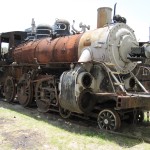 some were over 100 years old. A few of the locomotives were quite large, and the place would be absolute paradise for a steam engine enthusiast. One engine has been restored, but it is hard to imagine that they will have the resources to do very much in the near future. The whole thing seemed very informal and I gave the man a tip for letting me look round.
some were over 100 years old. A few of the locomotives were quite large, and the place would be absolute paradise for a steam engine enthusiast. One engine has been restored, but it is hard to imagine that they will have the resources to do very much in the near future. The whole thing seemed very informal and I gave the man a tip for letting me look round.
After retreating to the hotel for a while I had a look at the Centro Habana area, which contains some shopping streets. These shops were mainly for Cubans as opposed to the tourist shops in the old town, and many of them seemed to stock the same limited range of rather odd items. There were big tubs of DIY material and a vast selection of threaded pipe fittings. It appears that they stock what they can get, rather than what their customers want to buy. In these shops Cubans would pay in National pesos (CUP), whereas I would be charged in Convertible pesos (CUC), but in more out of the way places tourists can pay in CUP if they have them. The ratio of National to Convertible is about 24 to 1, which means that locally produced items work out vastly cheaper to Cubans than to tourists, but branded imported products are the same price or even more than in England, which puts them out of reach of many locals. Apart from cigars and rum, not many things are cheap to tourists.
As I walked about I was constantly offered cigars at bargain prices by people who claimed to have relatives working in the factory down the road, but these are always fakes, although they might not necessarily be poor quality.
On the road
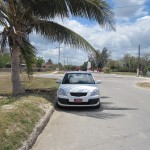 The next morning I was due to collect the hire car that I had booked several weeks earlier on the internet. There are about four car hire firms in Cuba, with a vast number of outlets, but in reality they are all owned by the government and if you book with one you can find that you are dealing with another. I finished up with Cubacar, which is probably the largest and had a desk in the Inglaterra hotel. At the appointed time a man turned up and the formalities were quickly completed. The car, a Kia Rio with 115,000km on the clock, was outside. It was covered in minor dents and scratches, most of which the man had marked on the paperwork, but he noted a few more at my request, laughing as he did so. In some ways, in a country like Cuba it is better to have a beaten up car, like most other people, than an immaculate one, although tourist cars are instantly identifiable anyway because they have different number plates. One thing to bear in mind is that in the event of an accident involving injury to a third party the driver will be detained by the police and cannot leave the country until the matter is fully resolved, which can take weeks or months. There are stories on the internet about specific foreigners being detained for long periods, but other stories saying that that is not true.
The next morning I was due to collect the hire car that I had booked several weeks earlier on the internet. There are about four car hire firms in Cuba, with a vast number of outlets, but in reality they are all owned by the government and if you book with one you can find that you are dealing with another. I finished up with Cubacar, which is probably the largest and had a desk in the Inglaterra hotel. At the appointed time a man turned up and the formalities were quickly completed. The car, a Kia Rio with 115,000km on the clock, was outside. It was covered in minor dents and scratches, most of which the man had marked on the paperwork, but he noted a few more at my request, laughing as he did so. In some ways, in a country like Cuba it is better to have a beaten up car, like most other people, than an immaculate one, although tourist cars are instantly identifiable anyway because they have different number plates. One thing to bear in mind is that in the event of an accident involving injury to a third party the driver will be detained by the police and cannot leave the country until the matter is fully resolved, which can take weeks or months. There are stories on the internet about specific foreigners being detained for long periods, but other stories saying that that is not true.
My night stop was to be Varadero, a coastal resort about 100 miles to the east of Havana. The main road follows the coast quite closely for most of the way and I turned off briefly to look at Guanabo, a pleasant little seaside town with a sandy beach. There were police checkpoints every few miles, and shortly after Guanabo I was stopped. The officer did not speak English, but he just said "Matanzas?, Varadero?". When I said "Varadero" he waved me on, so it seemed that he just wanted to know where I was going.
For some distance the road ran very close to the beach, and shortly before a place called Boca de Jaruco there were signs of an oil installation and nodding donkeys. At a roadside snack bar I stopped for a drink, and there were only two other customers, who had just finished their meal. They were big men, wearing special oil mens' shirts, and as they put their empty plates on the counter they said with American accents "Thanks for the lunch", and gave the man behind the counter a tip. Who else would tip someone in a roadside snack bar? They got in a flash crew cab pick-up and drove a couple of hundred yards down the road before turning off.
Over my drink I was puzzling about how American oil men could be in Cuba. As I drove away I looked at the place where the Americans had turned off, and it was an oil processing plant with three flags outside, one being Cuban, one I did not recognise, and the other Canadian. Mystery solved. Despite their almost total customs union with the USA, the Canadians seen to be quite happy to work with Cuba.
Some time later I came to a long bridge that crossed a beautiful gorge with a river running through it, and boats with a brilliant white wake trailing behind them. There was no traffic in sight, so I stopped briefly to take a photograph and then drove on. As I approached the end of the bridge I realised that there was watchtower with a policeman in it set back from the road, and needless to say he came down and stood in the road with his hand up.
I lowered the window and said very contritely "I shouldn't have stopped on the bridge".
He said "Documente!". I gave him my passport.
He said "Auto documente!" I gave him the car papers. He compared the names on the two documents and stared at me.
I said "I shouldn't have stopped on the bridge".
He folded the car papers up, gave them to me and said something in Spanish that appeared to mean "You shouldn't have stopped on the bridge", and waved me on.
So I was stopped by the police twice in the first 70 miles. This was obviously going to be a good trip.
Amazingly, I had also passed a van at the roadside with VEHICLE EXAMINER or words to that effect on it. I don't know what the standards are, but any vehicle examiner worth his salt would take three-quarters of the vehicles in Cuba off the road immediately, and yet they didn't seem to be stopping anybody.
Varadero
After passing through Matanzas, a pleasant city built around a bay, it was a boring but fast coastal drive to Santa Marta, the start of the  Varadero peninsular. On the approaches there is a 2CUC toll charge, although that only seems to apply if you come from the Havana direction, not from the south. There is then a bridge with a police checkpoint, after which, basically, it's welcome to Florida. Varadero has 18km of sandy beaches, hotels, three marinas, a golf course, and perhaps best of all, no hustlers. All people and cars passing through the police check point are scrutinised, and Cubans who have no good reason to be there are not allowed in. Even tourist cars carrying anyone who looks Cuban will be stopped and questioned.
Varadero peninsular. On the approaches there is a 2CUC toll charge, although that only seems to apply if you come from the Havana direction, not from the south. There is then a bridge with a police checkpoint, after which, basically, it's welcome to Florida. Varadero has 18km of sandy beaches, hotels, three marinas, a golf course, and perhaps best of all, no hustlers. All people and cars passing through the police check point are scrutinised, and Cubans who have no good reason to be there are not allowed in. Even tourist cars carrying anyone who looks Cuban will be stopped and questioned.
The resort is solely aimed at foreigners who come for a beach holiday, mainly on package deals, and it serves that purpose very well. After a bit of searching around I found a place called Villa Tortuga and booked a room for one night. It was a large complex with swimming pool etc. and amazingly I got a ground floor beach front room, inclusive of evening buffet meal and breakfast, for the equivalent of about £40. The beach was fabulous, with silver sand and palm trees, a real tropical paradise.
Varadero is actually quite an old resort, and has been developed in recent times partly with foreign investment, but is said to have lost a lot of its original character. As I walked along the beach the next morning it was very tempting to stay longer, but I had come to see Cuba, and this was not Cuba. The plan was to drive right across the country to Cienfuegos, a city on the south coast, about 120 miles (200km) away.
Across country
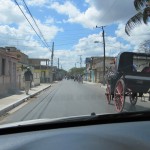 The first town I came to inland, called Cárdenas was, to say the least, a bit of a culture shock. It was late morning as I arrived, and at the start of the town there were a large number of cyclo-taxis and horses with carriages emerging onto the road from a school. Apparently it was school coming out time, and this was the local public transport. The streets were long and narrow, and these vehicles were jostling for road space with cars, lorries and bicycles, and it was a madhouse, just as I imagine India to be. I actually went back through the town to make a video, and although by the time I got to the school the traffic had died down somewhat, I still got some good scenes of the streets filled with horse-drawn carriages.
The first town I came to inland, called Cárdenas was, to say the least, a bit of a culture shock. It was late morning as I arrived, and at the start of the town there were a large number of cyclo-taxis and horses with carriages emerging onto the road from a school. Apparently it was school coming out time, and this was the local public transport. The streets were long and narrow, and these vehicles were jostling for road space with cars, lorries and bicycles, and it was a madhouse, just as I imagine India to be. I actually went back through the town to make a video, and although by the time I got to the school the traffic had died down somewhat, I still got some good scenes of the streets filled with horse-drawn carriages.
After Cárdenas the surroundings became much more countrified and there was little traffic. The fuel tank was under half full, and all the advice it to keep it well-filled because petrol stations are few and far between. The first filling station I passed had only diesel, but some distance later there was a village with a garage selling petrol. It actually had five pumps, two diesel, two unmarked and one marked 83 octane, which would not be unleaded. The car should have had 'Premium', which would be at least 90 octane unleaded and which I thought might be in the unmarked pumps. Almost all petrol stations in Cuba have attended service, and when the man came out it he went straight to the pump marked 83. I said "83?", to which he replied with a beaming smile "Yes, is good for car". I very much doubted whether it would be, but there was nothing else. From somewhere he produced a large lemonade bottle with the bottom cut off, stuffed the neck into the car filler, and put the leaded pump nozzle into the body of the bottle, thereby overcoming the problem of the leaded nozzle being too large to go in the unleaded filler pipe. Inevitably this resulted in petrol that I was paying for going all down the side of the car and over the wheel. Within a few miles I actually passed two more filling stations selling unleaded petrol, but it was too late then.
All the books say the signposting in country areas is almost non-existent but I did not find it too bad, although there is always only one sign, and that is right at the junction. There is no satnav mapping service available, and in any case it is inadvisable to bring a satnav into Cuba, because the authorities seem to regard them as a threat to state security. However, I did have a small car compass which worked quite well and was useful at times.
Between towns there are very few cars on the road, because people can't afford them. Public transport in the countryside is extremely limited, and the people rely largely on hitching lifts to get around, with the result that on the way out of every town or village and at most road junctions there will be people trying to get a lift. One guide book said "be generous with your space, some of these people will have been waiting for hours." I have to say that I found this quite difficult, because I did not like just driving past, but if you are on your own you are very vulnerable and the people know very well that a tourist is likely to have money and other valuables in the car.
There are some proper long distance buses for travel between towns, but it also very common to see people carried in old high-sided open military-style trucks, American or Russian, or even cattle trucks with a roof and slats in the sides. The open trucks are very high, 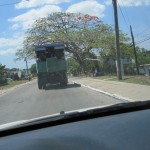 some with a staircase at the back, but many can be only be entered and exited by clambering up and down the sides, using the framework for handholds, which means that they are accessible only to the young and fit, who seem to enjoy travelling in them. Sometimes there are 20 or 30 people in these trucks.
some with a staircase at the back, but many can be only be entered and exited by clambering up and down the sides, using the framework for handholds, which means that they are accessible only to the young and fit, who seem to enjoy travelling in them. Sometimes there are 20 or 30 people in these trucks.
The countryside in this area was fairly flat, the staple crop being sugar cane, which, together with tobacco, is the main product of Cuba. In one place I saw oxen pulling a plough, but the fields are usually worked with ancient tractors and machinery of the same generation as the other vehicles. These machines look like solid lumps of rust, and it is amazing that they keep going. Some of the farmers ride around on horseback, wearing wide-brimmed hats and looking like Spanish gentlemen as they supervise the proceedings.
Living conditions in the countryside and small towns are mostly very poor, with people living in dilapidated wooden shacks or sometimes Soviet-style concrete 2- or 3-storey blocks of flats. These buildings may be associated with a particular source of employment, such as a factory or agricultural operation, and some have been abandoned. Some the of the towns have main streets lined with buildings of Spanish-period architecture and one of the depressing things about Cuba is to see so many fine buildings going to rack and ruin.
There are times when you could think you were in sub-Saharan Africa from the way people are living and travelling around, but you have to remember that in Cuba no one is starving, there are good medical facilities and universal education, with 100% literacy. Life expectancy is well up to normal Western standards at 74 for men and 79 for women.
Cienfuegos, the mountains and Trinidad
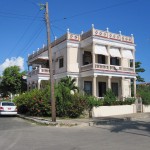 Eventually I reached Cienfuegos on the south coast, where I planned to stay the night. Most hotels are state
Eventually I reached Cienfuegos on the south coast, where I planned to stay the night. Most hotels are state 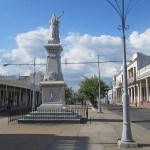 owned, apart from a few recently built ones in places like Varadero that are joint ventures with foreign investors, but there is another type of accommodation available to tourists called Casa Particulares which are private houses with one or two rooms to let. These are state approved and usually provide meals as well. There was one right on the bayfront called the Hostel Bahia recommended by the RG, and it proved to be very easy to find. It was a large detached house, run by very nice people, and it certainly showed that not everyone in Cuba is poor. Before dinner I went to look round the town, which was altogether smarter than the ones I had driven through on the way, probably because there is a lot of industry providing employment in the area. From my room I could see the harbour, used by tankers bringing oil from Venezuela, and alongside it a massive refinery.
owned, apart from a few recently built ones in places like Varadero that are joint ventures with foreign investors, but there is another type of accommodation available to tourists called Casa Particulares which are private houses with one or two rooms to let. These are state approved and usually provide meals as well. There was one right on the bayfront called the Hostel Bahia recommended by the RG, and it proved to be very easy to find. It was a large detached house, run by very nice people, and it certainly showed that not everyone in Cuba is poor. Before dinner I went to look round the town, which was altogether smarter than the ones I had driven through on the way, probably because there is a lot of industry providing employment in the area. From my room I could see the harbour, used by tankers bringing oil from Venezuela, and alongside it a massive refinery.
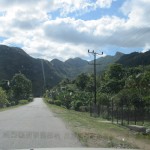 I booked for two nights in the Bahia and the next morning set off to go to Trinidad for the day. There were two routes, one more or less along the coast and the other over the mountains, which is the one I took. The mountains are not very high, only about 1150m (3700ft.), but the narrow tarmac road ran through the sort of lush green scenery that one would expect to find in South America. After about 30 miles, during which there was almost no traffic, I came to a village called Aguacate, where the road suddenly become impassable to ordinary cars, with a steep, loose sandy surface, broken away at the sides. I asked a man on horseback the way to Trinidad, and he pointed to the impassable road. I laughed and said I couldn't go that way, and he indicated that there was another way round, which I found and started driving on. However, after about a mile that got to the point where it was so rough that the car was bottoming out, and then it dropped away so steeply that I doubted whether I would be able
I booked for two nights in the Bahia and the next morning set off to go to Trinidad for the day. There were two routes, one more or less along the coast and the other over the mountains, which is the one I took. The mountains are not very high, only about 1150m (3700ft.), but the narrow tarmac road ran through the sort of lush green scenery that one would expect to find in South America. After about 30 miles, during which there was almost no traffic, I came to a village called Aguacate, where the road suddenly become impassable to ordinary cars, with a steep, loose sandy surface, broken away at the sides. I asked a man on horseback the way to Trinidad, and he pointed to the impassable road. I laughed and said I couldn't go that way, and he indicated that there was another way round, which I found and started driving on. However, after about a mile that got to the point where it was so rough that the car was bottoming out, and then it dropped away so steeply that I doubted whether I would be able 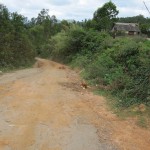 to get back up if I went down and could not get through further on. I got out and stood looking at this daunting terrain, when to my surprise a bus came the other way and started scrambling up the hill surrounded by a cloud of dust. But this was no ordinary bus, it was a modern 4x4 army style lorry with a box-like passenger body high up on the back, made in China. Following shortly behind it was a 4x4 taxi.
to get back up if I went down and could not get through further on. I got out and stood looking at this daunting terrain, when to my surprise a bus came the other way and started scrambling up the hill surrounded by a cloud of dust. But this was no ordinary bus, it was a modern 4x4 army style lorry with a box-like passenger body high up on the back, made in China. Following shortly behind it was a 4x4 taxi.
There was little doubt that the road did go to Trinidad, but not for someone in a Kia Rio, so I had to go right back to the coast road, and altogether I had gone about 50 miles out of the way on what should have been a 50 mile journey. Eventually I came into Trinidad and took a turning off the main road signposted Centro Historico, which led into a maze of cobbled streets. There were a lot of people standing around, and at the first junction I came to several men pointed at the offside front tyre and shouted "Flat tyre! Puncture!". Now, this is a well-known scam. As soon as you get out to look at the problem they reach into the car and snatch your worldly possessions, or at least anything they can get their hands on. So I drove about 100 yards down the road, with howls of protest coming from behind, stopped, jumped out and locked the doors. To my dismay, there really was a puncture, and within seconds my 'friends' had caught up with me.
Across the street was a garage forecourt with an airline but no one around, so they directed me into it, blew up the tyre and poured 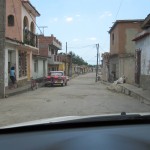 some water over it. Bubbles came out near the edge of the tread, confirming the puncture, and I asked them if they could repair it. They said they could, but not there, we must take the car round the corner into the next street, which I did. I got the jack out of the boot and they started taking the wheel off, while I was trying to keep a close eye on them and two other blokes who were sitting on the kerb the other side of the car. They said it would cost 25CUC (about £15) to repair the tyre, which was far too much for a repair that would probably be bodged so I told them to put the spare on. They said "No, no, we repair it". I shouted "PUT THE SPARE ON". They got the spare out of the boot, put it on and guess what? It had a puncture!
some water over it. Bubbles came out near the edge of the tread, confirming the puncture, and I asked them if they could repair it. They said they could, but not there, we must take the car round the corner into the next street, which I did. I got the jack out of the boot and they started taking the wheel off, while I was trying to keep a close eye on them and two other blokes who were sitting on the kerb the other side of the car. They said it would cost 25CUC (about £15) to repair the tyre, which was far too much for a repair that would probably be bodged so I told them to put the spare on. They said "No, no, we repair it". I shouted "PUT THE SPARE ON". They got the spare out of the boot, put it on and guess what? It had a puncture!
It was a bad tyre anyway, so I told them to put the original one back on. They protested strongly, but I insisted, gave them 2CUC and drove away, back to the main road. I realised that I would not be able to get far, but managed to find a proper big service station where I got the tyres mended. There were three punctures in the original one, which the man who mended it said were caused by the bad roads earlier on. One puncture was on the edge of the tread, which would no one would have repaired in England, but the tyre was still better than the spare, so I decided to carry on with it and drive carefully.
After all this I still went up to the Centre Historico, parked in the approved guarded car park and looked at the ancient buildings in the 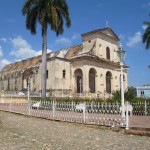 World Heritage Site. Perhaps my impression was coloured by the foregoing events, but I felt that Trinidad was grossly overrated and is not worth bothering with unless the subject of your PhD thesis is The Spanish Occupation of Cuba.
World Heritage Site. Perhaps my impression was coloured by the foregoing events, but I felt that Trinidad was grossly overrated and is not worth bothering with unless the subject of your PhD thesis is The Spanish Occupation of Cuba.
Back at the Bahia the evening meal was excellent, as the previous one had been, but there was another problem. My room was on a corner, directly opposite to a police station where a party was under way with extremely loud music, and went on until 12.30am. There was obviously no point in ringing the police, because they would not have been able to hear the phone and the people running the guest house were apologetic the next morning, but said they was nothing they could do.
From Cienfuegos I decided to more or less retrace my steps back to Varadero, but taking a better look at some of the places I had passed through, especially Cárdenas and another town called Colón. After a couple of hours I had a look at the damaged tyre and was not too sure about it, so I turned off into Aguada, a small town where I hoped there might be a garage. There was, and the tyre was ok, but I decided to make a video of the drive through the main street, with the camera mounted on the dashboard.
Police
Shortly after crossing the motorway north of Aguada I saw car parked in the road some way ahead, and as I approached I could see that it was a military-style 4x4 with a man in uniform standing by it. He indicated to me to stop, and as I did so I realised that the camcorder was still on the dashboard, which was a bit worrying because it might be regarded like a satnav as a piece of equipment to aid an imperialist aggressor to overthrow the Cuban regime. On this subject the Foreign Office advice is "Avoid military sites or other restricted areas. Be particularly careful when taking photographs or video film. Note that these areas are not always well signposted". The man in uniform appeared to be some sort of policeman, but different from the ones I had encountered previously. He asked me if I was going to Colón (the next town) and I said I was. He waved me on, but just as I started to move he put up his hand to stop me again and I thought he had noticed the camera. I did not know whether there were any gulags in Cuba, but thought I would shortly be finding out. However, he just pointed in the direction of Colón and said "25 kilometres". Phew!
Colón is a medium-sized town at an important junction on main roads with no direction signs at all, and I had briefly got lost on the way down, but made a good guess. This time I had a rather better look at the town than I had planned, because after driving round the centre 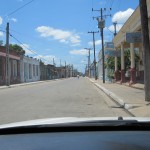 with the camera running I got seriously lost, but eventually found the way to the next town, Perico. The main road went straight through Perico, and at the end of the town on the way out there was the usual knot of people trying to get a lift, with a policeman in the middle of them. He waved me down, and it turned out that he wanted a lift to Matanzas, about 50 miles away. I was only going to Cárdenas, about 35 miles, but he said he would come with me, so it was lucky that I had taken the camera off the dashboard. He actually suggested a faster route than the one I was going to take, and talked all the way in quite good English that he had learned when he was a lifeguard years ago. He was 45, married with two sons and would be retiring in 5 years time, after 30 years in the police. As might be expected, he was quite anti-American and was concerned that the Cuban Americans would move to take over the country when the Castros go. While he was with me we went past a couple of police checkpoints and I was hoping we would get stopped but that did not happen.
with the camera running I got seriously lost, but eventually found the way to the next town, Perico. The main road went straight through Perico, and at the end of the town on the way out there was the usual knot of people trying to get a lift, with a policeman in the middle of them. He waved me down, and it turned out that he wanted a lift to Matanzas, about 50 miles away. I was only going to Cárdenas, about 35 miles, but he said he would come with me, so it was lucky that I had taken the camera off the dashboard. He actually suggested a faster route than the one I was going to take, and talked all the way in quite good English that he had learned when he was a lifeguard years ago. He was 45, married with two sons and would be retiring in 5 years time, after 30 years in the police. As might be expected, he was quite anti-American and was concerned that the Cuban Americans would move to take over the country when the Castros go. While he was with me we went past a couple of police checkpoints and I was hoping we would get stopped but that did not happen.
It was interesting to have contact with a policeman in this way, because the police presence in Cuba is far higher than I have seen anywhere else, even Russia. There is a high level of social control in the country, with widespread restrictions on freedom of speech, association and assembly. However, most of the time the police just seem to stand around and I did not get the impression that there is a bad relationship between the officers and the public.
After dropping the policeman in Cárdenas I drove on to the main square and within seconds a bloke tapped on the window, saying he was a guide and would show me round the town. I said I wanted to look round on my own, but he was very insistent and in the end I had to pay him 2CUC to not come with me. In return for another 2CUC he arranged for someone to keep an eye on the car, a practice that according to the RG is quite normal in Cuban towns.
He would have been delighted to have known that within a few minutes I was hopelessly lost in the maze of streets, but found the area that I had come through with all the horse-drawn vehicles the first time I was there. It was very hot and I went into a café for a drink. At a nearby table was a grossly made up woman sitting with a man, and she shouted across "Where are you from?" When I said "England" she came over, sat facing me and said "Do you want a woman?". I replied very stroppily "No, I'm too old for that sort of thing and anyway I'm fed with paying for everything". It was not clear whether it was her body that she was plying for hire or someone else's, but she went back to her table. Needless to say, when I eventually found my way back to the car there was no one looking after it.
In Varadero I went back to Villa Tortuga and got a room, not as good as the one I had previously on the beach, but as least there was no one asking me for 2CUC for baby milk.
Back to Havana
The plan for the next day was to go back to Havana via the airport to reconfirm my flight, and find accommodation in Miramar, a seaside suburb to the west of the capital. This meant going back through Matanzas and taking a road that looked quite good on the map to Madruga, then skirting round Havana on the motorway. Overlooking the bay in Matanzas were some newly finished large detached houses that would be worth at least £500,000 in England, and it would be interesting to know who is going to live in them in this relatively poor Communist country.
The road to Madruga proved to be of a lower standard than I expected, and was hard to find, but it ran through quite pleasant countryside and a fair number of villages and towns. After Madruga the surface deteriorated greatly, until in the end it was like a Russian road, and I was steering round the potholes. Eventually I came to the motorway, the first one I had used in Cuba, and it was a revelation. An almost empty dual carriageway, three lanes each way, with cyclists wobbling about in the outside lane and people with children walking along the inside one.
Finding the Air Europa office at the airport turned into an absolute nightmare, and by the time I got there it was closed. The are four terminals, a long way apart with few direction signs, and in the end a man from Terminal 2 came with me to show me the way to Terminal 3, but we were too late. Another 5CUC for him to get a taxi back.
By using the compass and some prayers I got through the outskirts of Havana to Miramar, and without too much trouble got a room on 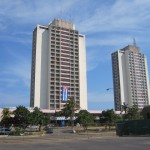 the 18th floor of the 22-storey Hotel Neptune overlooking the beach, which was the worst one I have seen outside Albania. Only two lifts were working out of four, and as I went up I just hoped that the mechanism was in better condition than most other machinery in Cuba. My room had a sea view, but the door to the balcony was locked, presumably to prevent people from throwing themselves off and crashing through the roof of the restaurant below.
the 18th floor of the 22-storey Hotel Neptune overlooking the beach, which was the worst one I have seen outside Albania. Only two lifts were working out of four, and as I went up I just hoped that the mechanism was in better condition than most other machinery in Cuba. My room had a sea view, but the door to the balcony was locked, presumably to prevent people from throwing themselves off and crashing through the roof of the restaurant below.
In the evening I wandered across the road to a modern supermarket with a guarded car park and had a look round. There were large areas of empty shelves and long rows of identical products such as bottles of drink, but a limited range of most items, including electronic goods, were available for those who could afford them. The checkout queues were very short because most people only had a few things, a big difference from Tesco's at home on a Friday evening.
It had originally been my intention to explore the area west of Havana before going to Varadero and Trinidad, but because of limited time on the first day I changed my mind. However, I thought I would now spend the last full day looking at the coast and country west of the capital. There is reputedly some beautiful countryside and coast in an area called Pinar del Rio, but it was too far to go for a day, so I stuck to the stretch of coast closer to Miramar and then turned inland. At first there were a number of pleasant beaches and a large marina, but then I came to a place called René Arcay which was like a very poor township, with dilapidated buildings and dust everywhere.
Inland was an industrial area with a power station and massive cement works from which the workers were just being driven away in 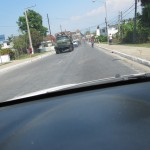 massive old truck-style buses, and from there I returned to Miramar on another deserted motorway.
massive old truck-style buses, and from there I returned to Miramar on another deserted motorway.
My return flight was late in the afternoon the next day, so before going to the airport I looked at two parts of Havana that I not seen, namely The Malecon and Vedado. The Malecon is the sea front promenade extending from the boundary of Miramar to the centre of the city, and amongst the distinctive buildings I passed were the Hotel Nacional (where several people were killed when a lift cable snapped in 2000) and the American Special Interests Section, which is a sort of embassy without an ambassador. The owners of glamorous American cars, especially convertibles, seem to regard the Malecon as the place to show off their vehicles.
The part of the city inland from much of the Malecon is Vedado, described by the RG as the cultural heart of Havana, with many museums, monuments, art galleries and a university. Some of the streets running inland from the Malecon are wide avenues, lined with houses once occupied by rich people but now used as government buildings or embassies. On the Sunday morning I walked right 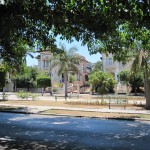 through to the Plaza de la Revolución and encountered only one hustler, probably because there were not enough people around for it to be worth their while going there.
through to the Plaza de la Revolución and encountered only one hustler, probably because there were not enough people around for it to be worth their while going there.
Emigration trauma
All advice is to allow plenty of time to get through the airport, up to 4 hours, when leaving the country. In addition to the usual things there is a 25CUC (about £15) fee which has to be paid before you are allowed to leave. Having done that and changed my remaining currency back to sterling I joined the queue for emigration. There were actually about 10 queues, all moving painfully slowly, and after about an hour mine came to a complete stop. Someone went and asked the two young ladies behind the window what was happening, and was told, with a shrug of the shoulders, that the computer had failed and they did not know how long it would be before it was sorted. Eventually we started moving again, and after another half hour I reached the window. The hall was stiflingly hot and I am sure some people must have been on the point of fainting.
I was asked to stare for some time straight at a camera, as I had been on entry to Cuba, and it seemed that the staff behind the window were calling up the two images on a computer to ensure that the people leaving were the ones who came in. As they looked at the pictures the young ladies were giggling and making comments, with a callous indifference for the welfare of the people in the queues. In the past I have encountered many stern-faced jobworths taking their time over doing their duty in such situations, and have received the boot camp treatment from bad tempered American airport security staff (though never immigration officers), but this was something quite different. It was an unhappy, slightly sinister combination of authority and immaturity, and left me wondering what the people who run the country are really like.
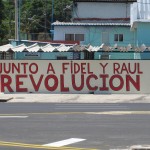 In many poor countries those people who have money have no hesitation in flaunting it, but in Cuba open displays of wealth are practically non-existent. It is said that behind some of the crumbling facades in Havana there are luxury apartments with all modcons, but few people apart from diplomats and tourists go around in expensive modern cars. There are some official political slogans around supporting the regime, and many hand written ones along the lines of 'VIVA FIDEL Y RAÙL', suggesting that there is a degree of popular support for the present leadership.
In many poor countries those people who have money have no hesitation in flaunting it, but in Cuba open displays of wealth are practically non-existent. It is said that behind some of the crumbling facades in Havana there are luxury apartments with all modcons, but few people apart from diplomats and tourists go around in expensive modern cars. There are some official political slogans around supporting the regime, and many hand written ones along the lines of 'VIVA FIDEL Y RAÙL', suggesting that there is a degree of popular support for the present leadership.
Many of the things that make the country so attractive to tourists are a consequence of the hardship that the country has suffered over the last 50 years, and it is hardly fair to hope that things will not change. Perhaps the best hope for the future is the recent discovery of large oil reserves just off the coast, currently being explored by a Spanish company, and this would enable the country to make its own way forward without being beholden to outside interests.
Classic Cars
The classic car scene in Cuba far exceeded my expectation. Everybody knows about the old American cars still in widespread use, but I had not realised how many British, other European, and Russian cars there were as well.
Once Fidel Castro came into power in 1961 imports from the USA ceased, so the American cars on the road cover the period from the late 1940s to 1961, and the European ones are also mainly from that time. There are virtually no pre Second World War cars other than in the museum (see below). From 1961 until 1991 the only vehicles imported were from the Soviet bloc, mainly Russia itself, and it is only comparatively recently that new vehicles have become available again, largely from the Pacific Rim and China.
American Cars
These are not really a special interest of mine, but no one could fail to be astonished at the number and variety on the roads, especially 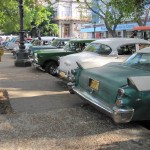 around Havana. Most are in well-used condition, and some are complete wrecks belching out clouds of smoke, but a few have been well restored. They range from the gangster-style saloons of the 1940s, with thick window frames, to the most outrageous finned monsters of the late 1950s. Parked at the side of the road you come across Edsels and Raymond Loewy Studebakers amongst other gems. Many are still used as taxis or can be hired with driver as a tourist attraction, but they are not available for self-drive hire.
around Havana. Most are in well-used condition, and some are complete wrecks belching out clouds of smoke, but a few have been well restored. They range from the gangster-style saloons of the 1940s, with thick window frames, to the most outrageous finned monsters of the late 1950s. Parked at the side of the road you come across Edsels and Raymond Loewy Studebakers amongst other gems. Many are still used as taxis or can be hired with driver as a tourist attraction, but they are not available for self-drive hire.
There is a small area of parkland in central Havana where American cars for sale are more or less permanently on display, as many as 60 or 70, like a motor show.
In addition to the big saloons and convertibles there are many Jeep-type vehicles and trucks around, from the same period. Also a few yellow school buses, and some trucks are used as buses in country areas.
British Cars
 There were far more British cars than I expected, dating from the same period as the American ones, and I had no idea that we had sold so many cars in Cuba. Amongst the most popular ones were:
There were far more British cars than I expected, dating from the same period as the American ones, and I had no idea that we had sold so many cars in Cuba. Amongst the most popular ones were:
Ford - Anglia 100E, Consul and Zephyrs Mks. I and II,
Hillman - Minx post-war Mks. I and II.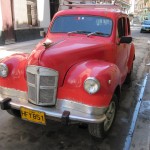
Vauxhall - Victor Mk. I
Austin - A40 Devon, A50 Cambridge, A55 Cambridge, A60 Farina
Morris - Minor
Also seen - Jaguar Mk.5, Hillman Husky, Standard 10, Hillman Avenger, Austin Metropolitan
Other European cars
Peugeot 403, 404
Fiat - 126 (many, may have come from Poland)
Simca - Aronde
Russian Cars
The most popular single make and model of any car in Cuba is the basic Lada, of which there are vast numbers. Second to that is the Moskvich, a car dear to my heart because I had one once although I did not actually own it. It belonged to a neighbour of my business premises in Littlehampton who had a 412 as an everyday car and bought a second rough one for spares. He asked me if he could keep it for a couple of weeks on my land while he took some parts off it. The couple of weeks turned into a couple of years, and the image of that dark metallic gold Moskvitch with matching areas of rust is indelibly etched into my memory. Judging by the numbers still running around Cuba they must have been far better cars than we thought they were at the time.
Many of them have been quite well restored and a favourite additional feature is a Ferrari badge on each side just ahead of the front 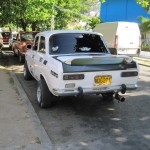 doors.
doors.
There are also a fair number of Volgas, UAZ 4x4 vans and Russian trucks.
Almost all of the old cars have been modified to some degree, either just to keep them running or, increasingly I think, to make them smarter. A very large proportion have modern flashy wheels, and quite a lot are jacked up at the back.
Motorcycles
Motorcycles are widely used, many with sidecars. By far the most popular makes are MZ, CZ/Jawa, and the Ural/Dnepr Soviet boxer twins, copied from BMW. There are some Japanese bikes, but I did not see any British ones at all.
In the last 10 years there has obviously been a trickle of new cars coming into the country, mainly from Korea, but some from Europe. Very recently new vehicles of all sorts have been imported bfrom China, including Geely cars, which are used by the police and some car rental outlets. The Geely has had a lot of European design input, and looks good. The vast majority of new buses, lorries and fire engines are from China. Also some electric scooters, which seem to be very popular in Cienfuegos.
Museo del Automóvil
It seems strange that a city that is a living car museum should have a building dedicated for that purpose, but Havana has. It is actually only a small museum, with an entry fee of 1CUC, unless you want to take photographs, for which there is an outrageous 5CUC extra charge.
The main space in the museum is given over to vintage cars, which are not generally seen on the roads. Most are American and in well- worn condition, but the most interesting one was a 1920s Rolls-Royce 4-seater open tourer in a dilapidated state but absolutely complete. An astonishing "barn find" which would be worth a fortune outside Cuba.
worn condition, but the most interesting one was a 1920s Rolls-Royce 4-seater open tourer in a dilapidated state but absolutely complete. An astonishing "barn find" which would be worth a fortune outside Cuba.
There was a separate roped-off area with an odd selection of vehicles in it, including an MG TD replica, possibly a VW-engined Lafer from Brazil, and a sports car that the lady in charge described as a Maserati, but I very much doubt whether it is. Also a Daimler DS420 limousine and several motorcycles including a Ducati.
Not the best car museum I have been to, but another one for the collection.
